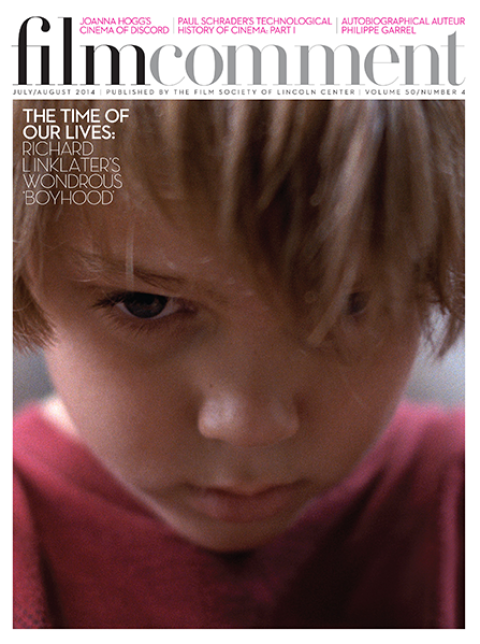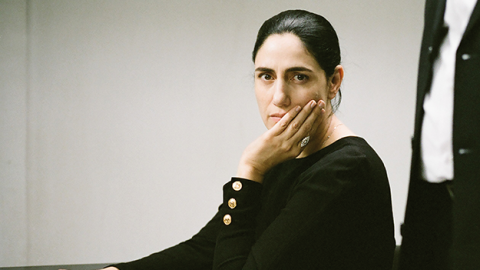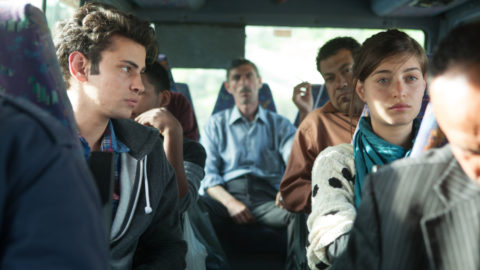There are those who believe that the Directors’ Fortnight has seen better days, whether the benchmark is several years or several decades old. Certainly the sleep-deprived correspondents to whom I mentioned my assignment—to take the measure of one year’s Quinzaine selection, from soup to nuts—seemed more inclined to murmur words of encouragement than envy. That wariness might partly arise from the unknown-quantity debuts on display and the varying mileage of its genre entries, both of which make up a significant portion of the lineup.

Gett, the Trial of Viviane Amsalem
For my money (which is a figure of speech that can be taken literally due to the high cost of attending Cannes), the 2014 titles that were new to me did have a clear standout in an Israeli film whose action largely unfolded within a single room. In Gett, the Trial of Viviane Amsalem, the sibling filmmaking team of Ronit and Schlomi Elkabetz, completing a trilogy that they began with To Take a Wife (04) and 7 Days (08), again set themselves certain formal limitations to unearth profound drama and mystery from the dry-sounding scenario of a protracted divorce trial before a rabbinical court. According to accepted archaic law, Viviane (Ronit Elkabetz) can only legally finalize her divorce with the complete consent of her husband, Elisha (Simon Abkarian). Supported by her lawyer (Menashe Noy), she returns again and again to court, with friends and family called as witnesses, but the man to whom she is unluckily bound holds firm, for increasingly opaque reasons in which anger, love, and pure male prerogative are merged together. As the months go by, time itself seems suspended, while the couple’s connection (or lack thereof) is increasingly suggested by what isn’t explained rather than what is.
While others testify that he’s a totally devoted husband, Elisha comes across as a real pill; never fully fleshed out by comparable testimony, Viviane understandably and bravely objects to being held up for scrutiny. Part of the appeal of this twistily written film—which effortlessly shifts from courtroom drama to feminist commentary to intense melodrama to black farce to some combination of existential conundrum and folk tale—lies in the way it maintains the impossibility of truly characterizing a relationship to outsiders. It’s more than a matter of he-said-she-said, since this isn’t some tabloid story of competing accusation; instead, from our limited vantage point, we are ultimately left to imagine for ourselves both the lived reality and essence of their marriage, while the often capricious rabbis continue to insist upon notions of the paramount importance of home and family, however irrelevant they quite evidently remain to Viviane in her situation. Spare and yet rich, Gett features a gallery of surprising and often funny characters taking their turns on the stage, and a stringent scheme of point-of-view camerawork that, while sometimes awkward, aptly underlines the subjectivity of the courtroom.

National Gallery
The best Quinzaine film not about a Jewish divorce court proceeding shared a little common ground with Mike Leigh’s Mr. Turner though not, to the enduring surprise of any listmaker of the world’s foremost auteurs, a place in the Competition. Frederick Wiseman’s National Gallery finds the filmmaker’s camera taking up residence this time in the preeminent London art museum, home to Mr. Turner as well as Messrs. Cézanne, Holbein, Giotto, van Eyck, Velazquez, and many other canonical artists. Wiseman’s 41st feature makes a ready counterpart to No. 40, last year’s At Berkeley in its heavy use of quotation—here, speeches by eloquent tour guides that send us back in time, painting by painting, and demonstrate the fine art of ecphrasis—and in its self-reflexivity as it ponders the problems of representation. (The movie was shot in HD, which at times, at the screening I attended at least, made the texture of some paintings seem a tad flat, but the very challenge of lighting and framing is itself addressed in a sequence about mounting an exhibition.)
The film’s edifying first half lingers in the halls of art, appreciating the aesthetic qualities and historical specificity of a series of works, with cutaways giving offhand portraits of museumgoers. Wiseman’s usual curiosity about institutional administration feels curtailed somewhat here but glimpses of decision-making bear witness especially to the insidious effects and rhetoric of marketing. But as the film progresses, Wiseman problematizes his subject matter: through scenes about restoration and about art depicting other artworks, the materiality of the museum and its contents comes to seem unstable, their meaning contingent upon framing in every sense. The stripping of rooms for a new exhibition (producing the film’s most abstract images), a poetry recitation, the recording of a pretentious art-history TV show, and a site-specific dance event underline the status of the museum as a perpetual performance space, where art comes alive, and stays strange, with each physical encounter.

A Hard Day
In addition to these two very disparate entries, and to its credit, the Quinzaine also hosted Kim Seong-hung’s rollicking thriller A Hard Day. Carefully orchestrated, beat for beat, the movie unfolds as a macabre comedy of errors and paranoia, as a cop in a casually corrupt department finds himself unable to wash his hands clean of a hit-and-run that refuses to stay covered up. Lee Sun-kyun, an honest-looking Hong Sang-soo regular, gets put through the wringer in action and fight sequences that take on a Rube Goldberg quality as the mishaps and accidents pile up, especially when a third party (effectively sinister and unpredictable Choi Jin-woong) intervenes. Highlights include a mano a mano apartment brawl and an extended gag involving a coffin; amusingly, the director cited Almodóvar’s Volver, or rather his speculation about the possible real-life aftermath of a key event in Volver, as an inspiration. Coming eight years after Kim’s first feature, A Hard Day marks a second debut of sorts, and one that portends well if he can maintain the same standards of pacing and freshness. (The same couldn’t be said of, say, Catch Me Daddy and the shouty Eat Your Bones, which vividly portray their respective criminal subcultures but break down as they go along. And the less said the better of These Final Hours, in which a gym bunny and a little girl face the apocalypse in, where else, Australia—I’ll take The Rover any day.)

Refugiado
On a rather different note, menace was deployed to nerve-fraying but meaningful ends in Diego Lerman’s Refugiado (“Refugee,” as in someone looking for safe haven), about a woman on the run from her violently abusive partner. Lerman’s hovering camera creates a sense of ambient unease as it tracks Laura (Julieta Diaz) and her 8-year-old son scurrying from women’s shelter to motel to backwoods hideaway. While some might complain that the Argentine filmmaker skirts the unseemly in squeezing so much around-the-corner suspense out of the husband’s pursuit—we know the potential consequences from an opening scene of Laura bloodied and dazed—the paranoia is true enough to the stalker behavior of many abusive husbands and the exhausting trauma of abuse, which lingers in the mind long after escape.

Tu dors Nicole
The merits of all the above notwithstanding, only one feature was apparently deserving of any recognition: Love at First Fight (Les Combattants), which swept the Quinzaine awards as well as FIPRESCI’s sidebar prize. It’s a diverting, crowd- pleasing debut from French filmmaker Thomas Cailley, pairing two idle teens, a kid (Kevin Azais) working for his family’s construction company and a tough tomboy (Adèle Haenel) whose nerd-rage and mercenary self-interest are entertaining until they start to pose problems. The comedy, despite straining for effect with a cleansing forest-fire climax, owes some of its feel to American indie influences, though along those lines, Stéphane Lafleur’s Tu dors Nicole (“You’re Sleeping, Nicole”) also had lazy-summer charms worth noting. In this sedately black-and-white film, a thrift-store clerk hangs out with her best friend in the family house; the parents are on vacation, and her brother and his band have moved in for relentlessly noisy practice sessions and attendant adolescent distractions. I slightly preferred the Quebecois filmmaker’s deadpan heroine, Nicole (Julianne Côté), to those of Love at First Fight, even though the film’s tone and weakness for gimmicks (e.g. the device of Nicole’s pubescent suitor being deeply voiced by an adult is funny but overused) verged on quirkiness.

Girlhood
The selection also featured a pair of Sundance star graduates (Whiplash and Cold in July), more by pastmasters (John Boorman’s Queen and Country, and Studio Ghibli co-founder Isao Takahata’s The Tale of the Princess Kaguya), and a special screening of Bruno Dumont’s miniseries-turned-feature L’il Quinquin, easily another of my favorites. But to end with the beginning: as silly as it can be to search for themes in a festival lineup, the Quinzaine opener Girlhood does suggest a recurring motif—women called upon, or unpleasantly forced into, justifying and asserting their own personal narratives. For the French-African teenagers of Céline Sciamma’s latest (and overly mannered) feature, the solidarity and brio of a girl gang partly shields its members from the paternalistic hierarchy around them. But the Quinzaine doesn’t need the justification of some hold-all generalization or the delivery of the sort of éclat associated with the main festival, for the strength of its individual efforts to make themselves felt.






